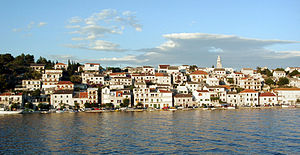Island Brac
Brač (Croatian pronunciation: [brâːtʃ]; local dialect: Broč; Latin: Bretia, Brattia; Italian: Brazza) is an island in the Adriatic Sea within Croatia, with an area of 396 km²,[1] making it the largest island in Dalmatia, and the third largest in the Adriatic. Its tallest peak, Vidova gora, or Mount St. Vid, stands at 778 m, making it the highest island point in the Adriatic. The island has a population of 14,436,[2] living in numerous settlements, ranging from the main town Supetar, with more than 3,300 inhabitants, to Murvica, where less than two dozen people live. Bol Airport on Brač is the largest airport of all islands surrounding Split.
History
Archaeological findings date the existence of human communities on the island back to the palaeolithic (in the Kopačina cave between Supetar and Donji Humac). Nevertheless, there are no traces of human habitation from the neolithic. In the Bronze Age and Iron Age, Illyrian tribes populated the inner parts of the island. Numerous villages existed at that time (but none of them survived).In the 4th century BC Greek colonisation spread over many Adriatic islands and along the shore, but none of them on Brač. Nevertheless, Greeks visited the island and also traded with the Illyric tribes; Greek artifacts were found in the bay of Vičja near Ložišća on the estate of the Rakela-Bugre brothers. Many of the objects belonging to this still unexamined site are now on display in the Archeological Museum of Split. Brač lay on the crossroads of several trade routes from Salona (today Solin) to Issa (today Vis) and the Po River.

Supetar harbour
In the year AD 9, the Romans finally conquered Dalmatia after long fights against the native tribes. Salona became the capital of the new province and, probably because of its proximity to Salona, no bigger villages or towns were founded on the island. Signs of Roman habitation can be found all over the islands, but they usually remain single Roman villas, cisterns, and especially early quarries between Škrip and Splitska. Splitska also became the most important harbour to carry stone to Salona and the whole of Dalmatia. Diocletian's Palace, which later became Split, was largely built with limestone that was quarried on Brač.[3] Also agriculture, especially wine and olives, began in the same era.After the destruction of Salona by Avar and Slavic tribes, Brač became a refuge for many denizens of the shore. Tradition has it that Škrip was founded by refugee Salonans, but the town is actually much older than that.From AD 1268 to 1357 the island recognised the supremacy of the Republic of Venice, and after that they bowed to the Kingdom of Hungary. In the summer of 1390, together with the whole region, they accepted the rule of the Bosnian King Tvrtko Kotromanić, who died the next year.[4] Soon after his death, Hungary claimed the island again. In this whole period, they kept their basic autonomy and old structures – the island was never rich or strategically interesting enough to justify serious intervention. Local nobility administered and ruled Brač and the seat of the council was Nerežišća in the island's center. The leader was selected from the noble families. Only in 1420 did the Venetian Republic reclaim the island, finally sending someone to lead the island.Venice ruled for more than four centuries, until 1797, when the Habsburg Monarchy annexed most of its territory in a deal with Napoleonic France. The official language was Latin. During this time, the Bosnian realm fell to the Ottoman Empire and many refugees settled on the islands, especially on Brač. Many towns were founded in that time and the population began moving from the interior of the island to its coast: to Bol, Milna, Postira, Povlja, Pučišća, Splitska, Sumartin, Supetar i Sutivan.During the Napoleonic Wars, Brač was conquered by the French Empire for a short time in 1806. In 1807, Prince-Bishop Petar I Njegoš of Montenegro managed to seize Brač with the help of the Russian navy, however already at the Congress of Vienna in 1815 the island was returned to the Austrian Empire. Brač was incorporated into the Austrian crownland of Dalmatia from and became a part of Transleithania of the Monarchy of Austria-Hungary from 1867. After the fall of Austria-Hungary 1918, Brač became part of the Kingdom of Serbs, Croats and Slovenes, or Yugoslavia since 1929. In 1939 an autonomous Croatian Banate was created that included the island.
The population of the island drastically decreased in the beginning of the 20th century due to heavy emigration, mostly to Latin America, especially Argentina and Chile, and to New Zealand and Australia. The emigration continued during the whole century, only later generations preferring to move to European countries, especially Germany.In 1941 Italian forces occupied the island. In the mountainous regions of the island, native rebels fought a quite effective guerilla war, but the occupiers answered harshly with arrests and executions. After the Italian capitulation in 1943, German troops occupied the island on January 12 and 13 of 1944, but in July they were defeated and the island was freed.[5] As part of Croatia it became part of the Socialist Federal Republic of Yugoslavia, until Croatia gained its independence in 1991, receiving recognition in 1992. The Croatian War of Independence was barely fought on the island (there was a brief bombing of Milna), but the aftermath of the war, especially the loss in tourism, was disastrous for the island. Only now is the island regenerating from the decade-long drainage of its most important revenue.
Economy
The economy of Brač is based mostly on tourism, but fishing and agriculture (especially wine and olives) are very important too, as is its precious white stone which was used in building Diocletian's Palace in Split and the Canadian National Vimy Memorial.[6] Historically, Brač was famous for goats; even Pliny comments that from the island of Brattia (the Latin name for the island) comes excellent cheese, wine and olive oil.
Administration and settlements
The island is administratively divided into one city and seven municipalities, including the twenty-two settlements. Population numbers are given per 2011 census.[7] The island is part of the Split-Dalmatia County, but is not represented there as a whole, only through its city and municipalities.Source: Wikipedia

